MARIANI’SVirtual Gourmet
January
1, 2012
NEWSLETTER
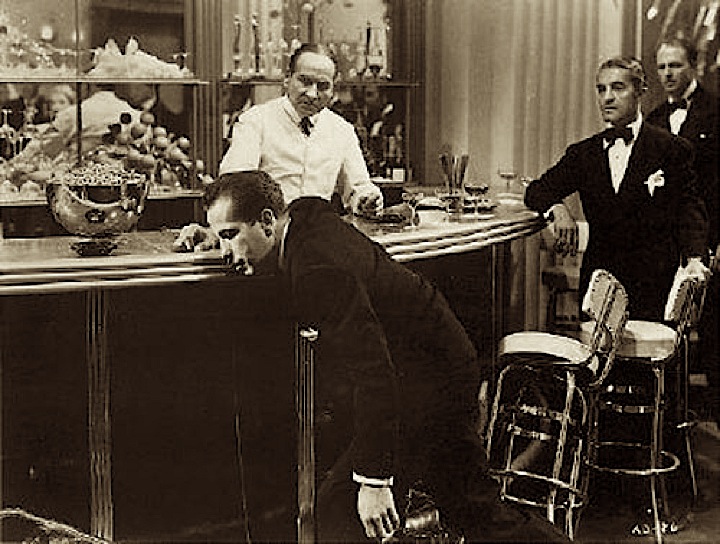
Humphrey
Bogart in "Angels with Dirty Faces" (1938)
❖❖❖
THIS WEEK
by Carey Sweet
NEW YORK CORNER
La Promenade
des anglais
by John
Mariani
NOTES FROM THE WINE CELLAR
BORDEAUX AND DEAD GUYS
by Brian Freedman
❖❖❖
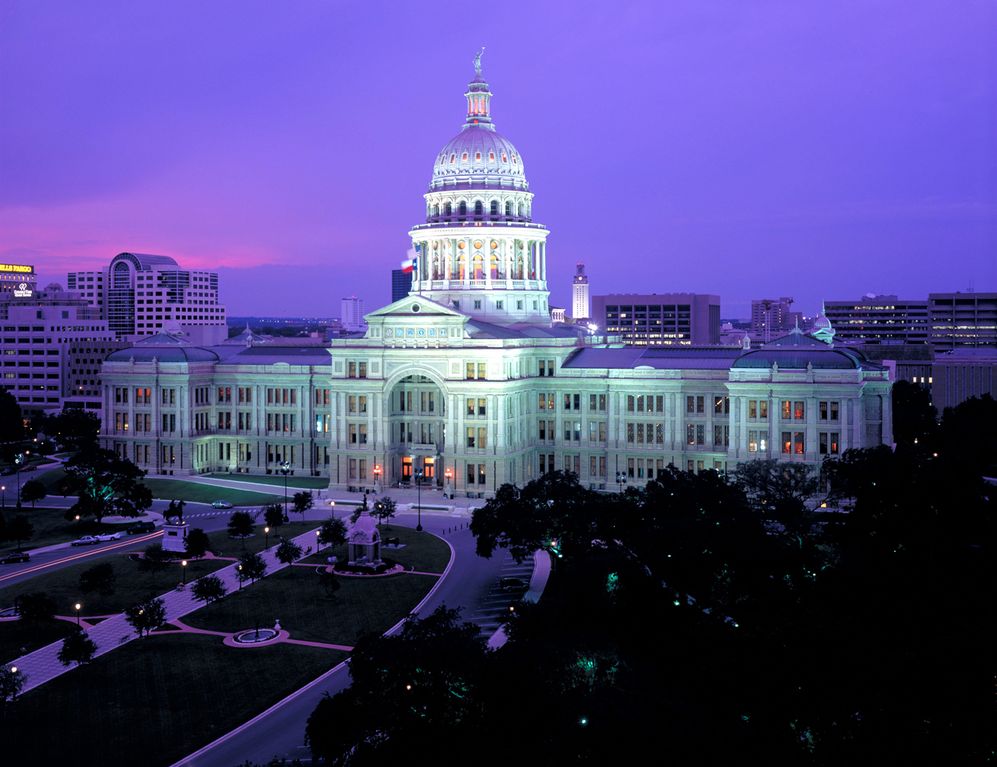
So
as our small group toured the intimate, 2,750-seat
venue, when we entered the top balcony mere feet away
from where my beau strummed his guitar, we were not to
attempt eye contact. Silly manager. Because of
course, Jackson Browne, my heart throb since I first
heard his crooning when I was in elementary school
(the year was 1972, the album was Jackson Browne)
looked up, saw the half dozen of us trying to be
invisible, and gave a wave and a hearty, “Hey there.”
Well. If only the manager had allowed me close enough
to tell Browne, now 63, that he had been my true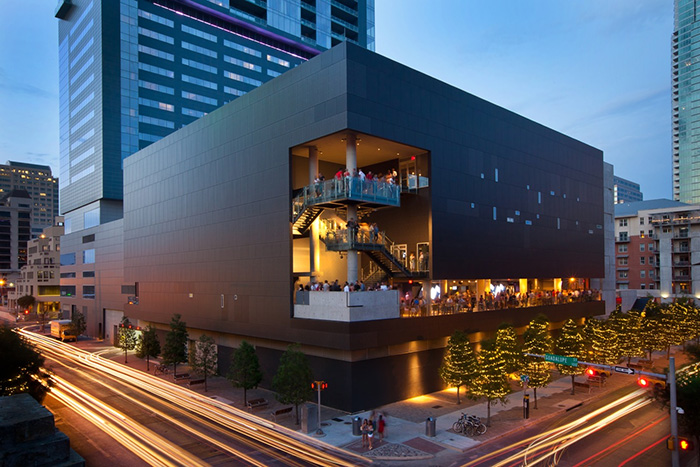 love all these years. As it was, thanks
to the remarkable set-up of the auditorium, with
nearly every seat within personal-message screaming
distance, I finally got to see him up-close. From the
gray in his sexy brown hair, to the wrinkles that make
this Rock and Roll Hall of Famer so distinguished, he
still made me swoon.
love all these years. As it was, thanks
to the remarkable set-up of the auditorium, with
nearly every seat within personal-message screaming
distance, I finally got to see him up-close. From the
gray in his sexy brown hair, to the wrinkles that make
this Rock and Roll Hall of Famer so distinguished, he
still made me swoon.
Austin has always been a music
town. Its heart beats with the rhythmic thumps of the
downtown/warehouse/Sixth Street entertainment
districts crowded with notable clubs like Continental,
Antone’s, and until this month, Emo’s (now Emo’s
East). And since ACL theater debuted in February 2011
at Willie Nelson Boulevard between Lavaca and
Guadalupe streets, the venue has become a glittering
centerpiece, attracting performers such as Diana Ross,
Devo, and of course, mi amor
Browne.
ACL Live is the dream of Freddy
Fletcher, nephew of Texas icon Willie Nelson, and it
celebrates rock-n-roll, country, jazz and all music in
all its glory. The theater is the set for the KLRU-TV
produced PBS series “Austin City Limits,” the longest
running music show in American television history. No seat is
more than 75 feet from the stage, and there are 12
bars, five luxury suites, a full recording studio and
a custom Meyer sound system.
With the opening of the W Hotel on
Lavaca Street in December 2010, the music bar has
risen even higher, for what is essentially a
state-of-the-art concert venue connected to a posh
hotel. After the last strains of Browne’s second
encore trailed away, I simply walked across a
mezzanine to get back to my room. There were no
detours save an invitation-only party playing on the
patio to promote the new Cinco Five Star Vodka from
San Antonio. So I suppose I shouldn’t have been
surprised when I had checked in to the W earlier that
day, with its neon blue lit registration desks,
retro-chic rotary telephones, and techno music
throbbing through every open space, that much of the
clientele seemed to be party animals barely
celebrating drinking age. There were pretty young
things – both boys and girls – sipping cocktails in
the multiple lobbies, and in the elevator as I rode up
to my room. When I came back down to get a cocktail of
my own in the bar that isn’t a “bar” but “The Living
Room” and so dark and pulsing with red lighting that
it would make a lovely home for a vampire, there was
Chelsea Clinton wandering through an adjacent lounge
looking for a friend’s bachelorette party.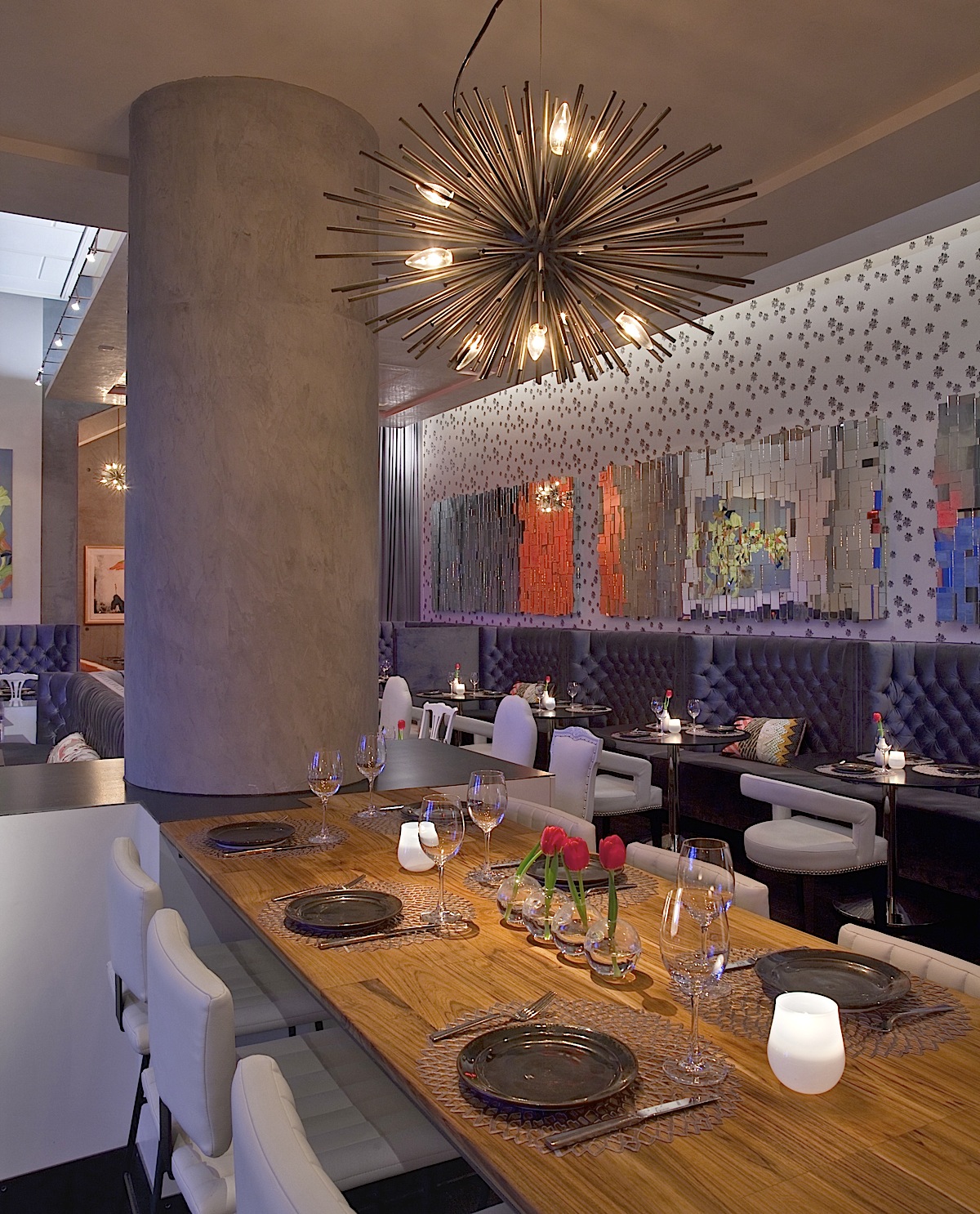
The hotel is so high energy that
its amenities are verbs, typed in capital letters: the
gym is called SWEAT; the pool is called WET; the spa
offers the AWAY massage; the
restaurant is called TRACE (right), for
its commitment to seasonal, local goods sourced by an
on-staff forager.
The hotel
has its own cultural concierge, Caleb Campaigne, who
knows the ins and outs of what's cool in this dynamic
college town. Rather than handing guests a tired
guidebook, he asks, “Darling, what’s your scene?” Once
he determines your profile, he will steer you
properly: it might be an upscale, prix fixe Natural
American dinner from chef David Bull at Congress (below)
around the block (named one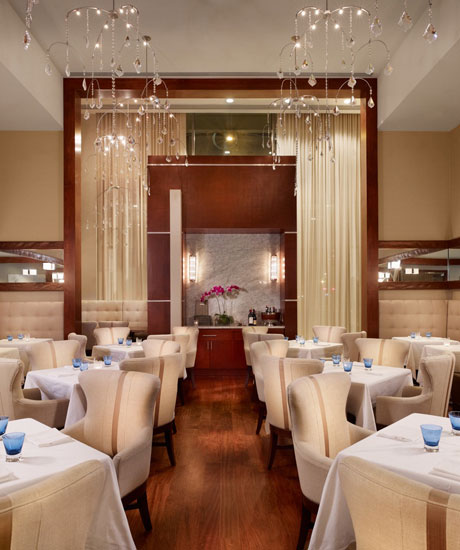 of Esquire's
Best
New Restaurants 2011), or it could be a midnight
cocktail at the very hot, yuppie-artsy Star Bar in the
Warehouse District, where $11 will get you a tasty
little Southern Cross of pomegranate liqueur, vodka,
St.-Germain elderflower liqueur and champagne in a
martini glass.
of Esquire's
Best
New Restaurants 2011), or it could be a midnight
cocktail at the very hot, yuppie-artsy Star Bar in the
Warehouse District, where $11 will get you a tasty
little Southern Cross of pomegranate liqueur, vodka,
St.-Germain elderflower liqueur and champagne in a
martini glass.
Certainly one can do some damage
right in the hotel, where that Living Room is plush
with couches and upholstered walls in a cozy den with
a bar framed by silver gray glass striped with
mercury. A McIntosh stereo from the 1960’s plays
tunes, and the bartender confides as he stirs Crown
Royal whisky with cooked-down Dr Pepper syrup, “A good
stereo sells a lot of cocktails.”
TRACE, too, is easily a destination
restaurant, reflecting the national fad for locavorism
that’s alive and well in Austin. The mood is swank,
with walls of French style doors sliding open to the
patio, tufted gray velvet banquettes, dark wood floor,
Moroccan rugs and sparkling mirrored walls. If it
feels a little night clubby, the food focuses a
serious Central Texas-theme menu that chef Paul
Hargrove sources from regional farms. That can
mean grilled Texas quail moistened in smoked tomato
glaze with hard-boiled quail eggs and fried pickled
jalapeño; roasted beet salad in Kinloch
Plantation pecan vinaigrette with Full Quiver cottage
cheese, fried pecans, and red veined sorrel; or Gulf
redfish baked in banana leaf with organic peppers,
oregano and grilled green onions over coconut black
bean tamales. (The locavore here idea is
little strained: Kinloch Plantations is in Winnsboro,
Louisiana, and Full Quiver in Suffolk, Virginia.)
W executive chef Nadine Thomas
shops at The
Austin Farmers' Market (below) hosted since 2003 at nearby
Republic Square Park  on Saturdays, paying with
wooden $5 tokens for Texas French bread and Sweetish
Hill bread, raw milk cheeses, duck eggs from Harvest
Time Farm Stand in Canyon Lake, and wild Texas guajillo honey.
This is a gathering spot for most of the city’s food
community, it seems, browsing Asian opo squash,
amaranth, purslane, pea tendrils, lambs quarters, and
turnips, kohlrabi and fiesta beets from Tecolote Farm
of Manor, Texas.
on Saturdays, paying with
wooden $5 tokens for Texas French bread and Sweetish
Hill bread, raw milk cheeses, duck eggs from Harvest
Time Farm Stand in Canyon Lake, and wild Texas guajillo honey.
This is a gathering spot for most of the city’s food
community, it seems, browsing Asian opo squash,
amaranth, purslane, pea tendrils, lambs quarters, and
turnips, kohlrabi and fiesta beets from Tecolote Farm
of Manor, Texas.
People bring their dogs – Afghan
hounds, mountain dogs, beagles, a three-legged
doberman – and chat with vendors like Patrick
Fitzsimons, co-owner of Thunderheart
Bison from Shape Ranch in Carrizo Springs. He
runs 250 head and doesn’t stress his animals by taking
them to slaughter. “I harvest with my rifle in the
field,” he explains. “They spend their lives happy, in
the pasture, doing their bison thing.” The ranch is
certified by the Animal Welfare Institute.
Yet for all the high-end
experiences available, one of the most innovative
developments in Austin’s creative style is a new
dining subculture called "trailer park cuisine." As
the name implies, packs of food trucks occupy pockets
up and down and around SoCo, a vibrant, colorful
stretch of Congress Avenue between Oltorf and Town
Lake that is also lined with funky shops, art
galleries and restored motels that just a few years
ago catered to transients but now draw well-heeled
hipsters. The stretch of road between Milton and
Monroe streets has its trendy restaurants, but there’s
just as much activity at the main park, where regional
favorites are prepared in and served from bohemian
trailers including Airstreams, vintage Winnebagos and
old school buses. Diners sit at gaily decorated picnic
tables, feasting on chili, ribs, Tex-Mex, seafood,
Cajun-Creole, and deli. When they’re done, they
deposit their rubbish in bins cutely titled “trailer
trash.”
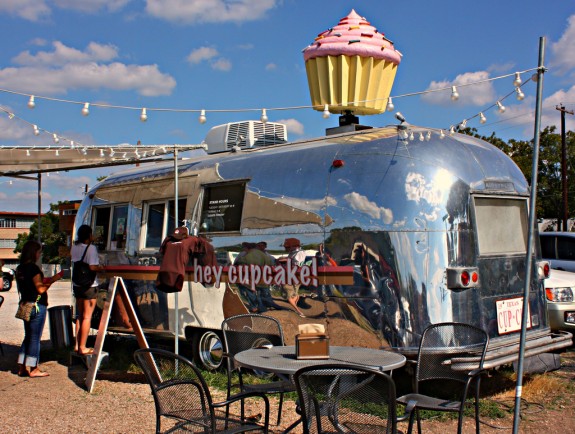 Proposed
hotel development is looming now to push the SoCo
stylish encampment out, but for the time being, the
food court is populated by such fun spots as Hey
Cupcake (the rotating pink cupcake on top of the
silver Airstream promises vegan treats), Austin Frigid
Frog (for shaved ice, but also bacon-chicken doggie
cones sold for $2, with half the proceeds to benefit
animal shelters), Mighty Cones (avocado crusted in
almonds, sesame seeds, chile flakes, corn flakes in a
tortilla cone topped with mango-jalapeño slaw),
and Coat & Thai (pad
see-ew stir-fried flat noodles with egg,
broccoli and brown sauce).
Proposed
hotel development is looming now to push the SoCo
stylish encampment out, but for the time being, the
food court is populated by such fun spots as Hey
Cupcake (the rotating pink cupcake on top of the
silver Airstream promises vegan treats), Austin Frigid
Frog (for shaved ice, but also bacon-chicken doggie
cones sold for $2, with half the proceeds to benefit
animal shelters), Mighty Cones (avocado crusted in
almonds, sesame seeds, chile flakes, corn flakes in a
tortilla cone topped with mango-jalapeño slaw),
and Coat & Thai (pad
see-ew stir-fried flat noodles with egg,
broccoli and brown sauce).
If the park is forced to move,
things will still be fine, since other truck teams
thrive all over the city. Downtown, there is Lucky
Pucia’s Wood Fired Italian Sandwiches with a real wood
fired oven, on First Street sits Azafrán for
Texas-style tapas, Wasota African Cuisine, and Sushi
A-Go-Go, plus dozens of others like the
you-gotta-love-it Biscuits & Groovy. Torchy’s
Tacos is hugely popular in multiple locations, serving
a signature Trailer Park taco stuffed with fried
chicken and cheese.
The grandeur of ACL Live aside, no
trip to Austin is complete without a visit to
Continental Club, the famous dive and enclave of
fabulous 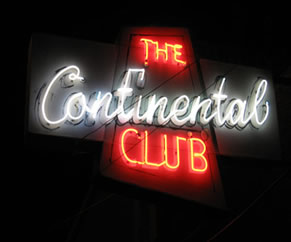 music since 1957. Dark and a
bit grungy and always insanely packed, it hosts the
who’s who of alternative and progressive country,
alternative rock, and a whole lot of blues.
There was a blues band playing the night I was there,
though I forget who, since I was more distracted by
the bizarre dancing of ex-Silver Spoon child
star/"NYPD Blue" actor Ricky Schroeder with celebrity
hair stylist José Eber. They cut the rug, then
roared off into the night in a shiny Bentley.
music since 1957. Dark and a
bit grungy and always insanely packed, it hosts the
who’s who of alternative and progressive country,
alternative rock, and a whole lot of blues.
There was a blues band playing the night I was there,
though I forget who, since I was more distracted by
the bizarre dancing of ex-Silver Spoon child
star/"NYPD Blue" actor Ricky Schroeder with celebrity
hair stylist José Eber. They cut the rug, then
roared off into the night in a shiny Bentley.
Readying for
bed back at the W at two a.m., I pulled the curtains
closed against the still-bright city lights and saw
the drapes’ edges were trimmed in guitar strap fabric.
There was an invitation on the desk to explore the
photo gallery inside ACL Live, chronicling the many
legends who have helped make Austin famous. Next to
that: a room service menu for pets, featuring a $16
grilled Niman Ranch doggie burger.
What fantasy of food and music
would come next in this crazy fun Austin, I wondered?
In-room breakfast served by Elvis?
Award-winning
writer Carey
Sweet lives
in Sonoma County, CA, splitting her time between
Scottsdale and the North Bay, where she isa regular
contributor to the San Francisco
Chronicle,
944 San Francisco magazine, a Dining
News column for the Arizona Republic, a monthly food
feature column in Phoenix Magazine.
NEXT WEEK: EATING AROUND AUSTIN by John Mariani
❖❖❖
NEW
YORK CORNER
BY
JOHN MARIANI
LA
PROMENADE des
Anglais
461 West 23rd Street (near Tenth Avenue)
212-255-7400
www.lapromenadenyc.com.
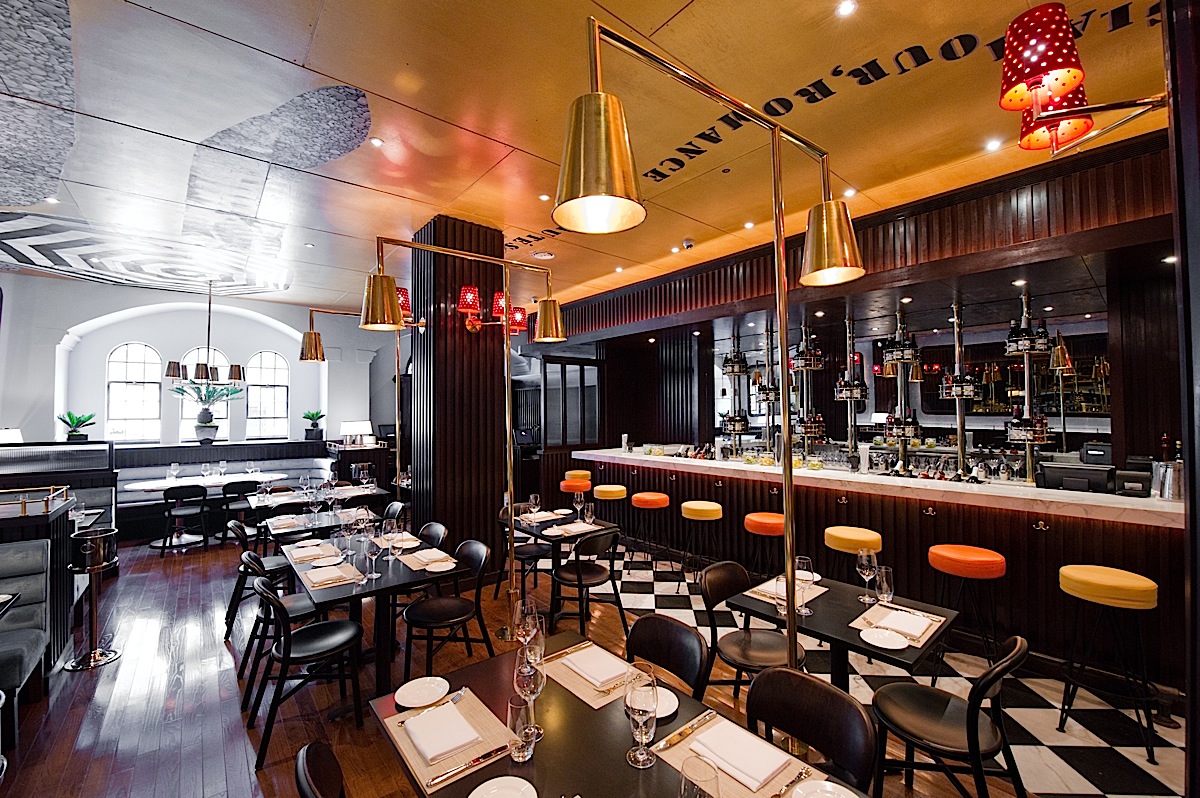 La
Promenade des Anglais--nicknamed "La Prom"--is
Nice's broad seaside boulevard, so often painted by
Raoul Dufy. Chef Alain Allegretti grew up in Nice,
his father was from Palermo. So it all made
sense for him to open a restaurant with such a
nostalgic name; after tasting a broad sampling
of his new restaurant's menu, I can see how much he
longs for those sunny days and mix of French,
Italian, and North African cuisines.
La
Promenade des Anglais--nicknamed "La Prom"--is
Nice's broad seaside boulevard, so often painted by
Raoul Dufy. Chef Alain Allegretti grew up in Nice,
his father was from Palermo. So it all made
sense for him to open a restaurant with such a
nostalgic name; after tasting a broad sampling
of his new restaurant's menu, I can see how much he
longs for those sunny days and mix of French,
Italian, and North African cuisines.
Open just three months and
located in Chelsea's London Terrace Buildings, La
Promenade (LPA, we'll call it) has a décor
that somewhat evokes Nice through a charming
paper collage
inspired by the pebble beaches there and brass
lighting fixtures vaguely like the street lights that
line the Boulevard. There are also antique
mirrors, Mediterranean blue velour banquettes, dark
wood, and black and white marble floors.
Allegretti (below) wants
people to feel comfortable here and the cheery service
staff sets the mood by wearing jeans and sneakers. 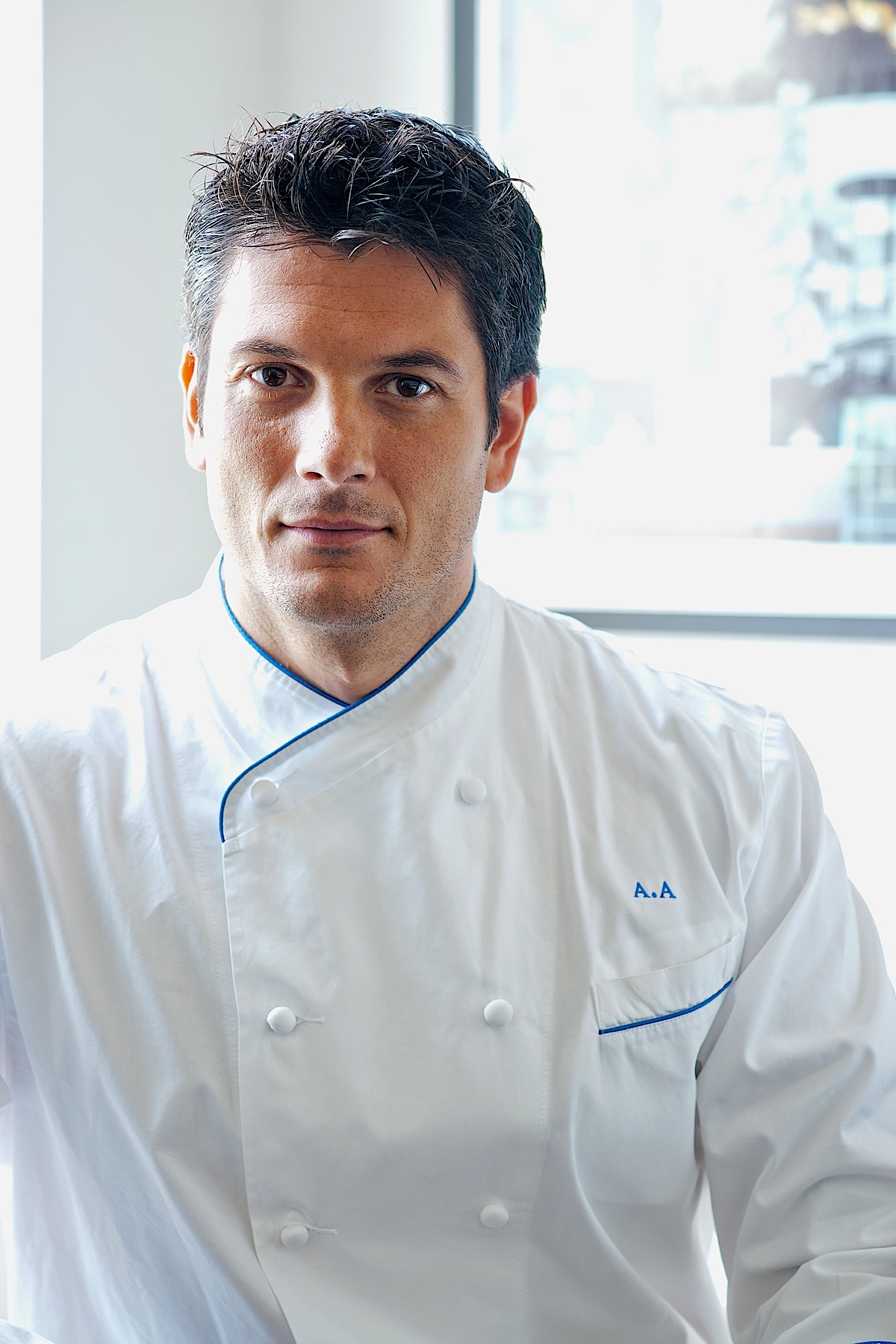 At peak
periods the dining room can be very, very loud, not
least because of the intrusion of booming music, which
I am told includes Edith Piaf but sounds more like
Lil' Kim Piaf.
At peak
periods the dining room can be very, very loud, not
least because of the intrusion of booming music, which
I am told includes Edith Piaf but sounds more like
Lil' Kim Piaf.
It's a place you should share with
friends, starting with the "For the Table" items,
including salt cod brandade crostini (below) with
prosciutto and a spicy tomato concassée;
golden crisp zucchini flower beignet puffs; roasted
baby artichokes with an anchovy sauce and tomato
confit; and irresistible, tender fried gnocchi. (Some
day I'm going to ask Allegretti if he can make that
weird Niçoise specialty called gnocchi merda de can.)
Then there is the appetizer
section, with a hearty green lentil soup, nicely
seasoned and set with a poached egg and baby spinach
to provide additional textural interest, and a good
garlicky Provençale soupe des poissons, with the classic
Gruyère and rouille.
I was so happy to see frogs' legs 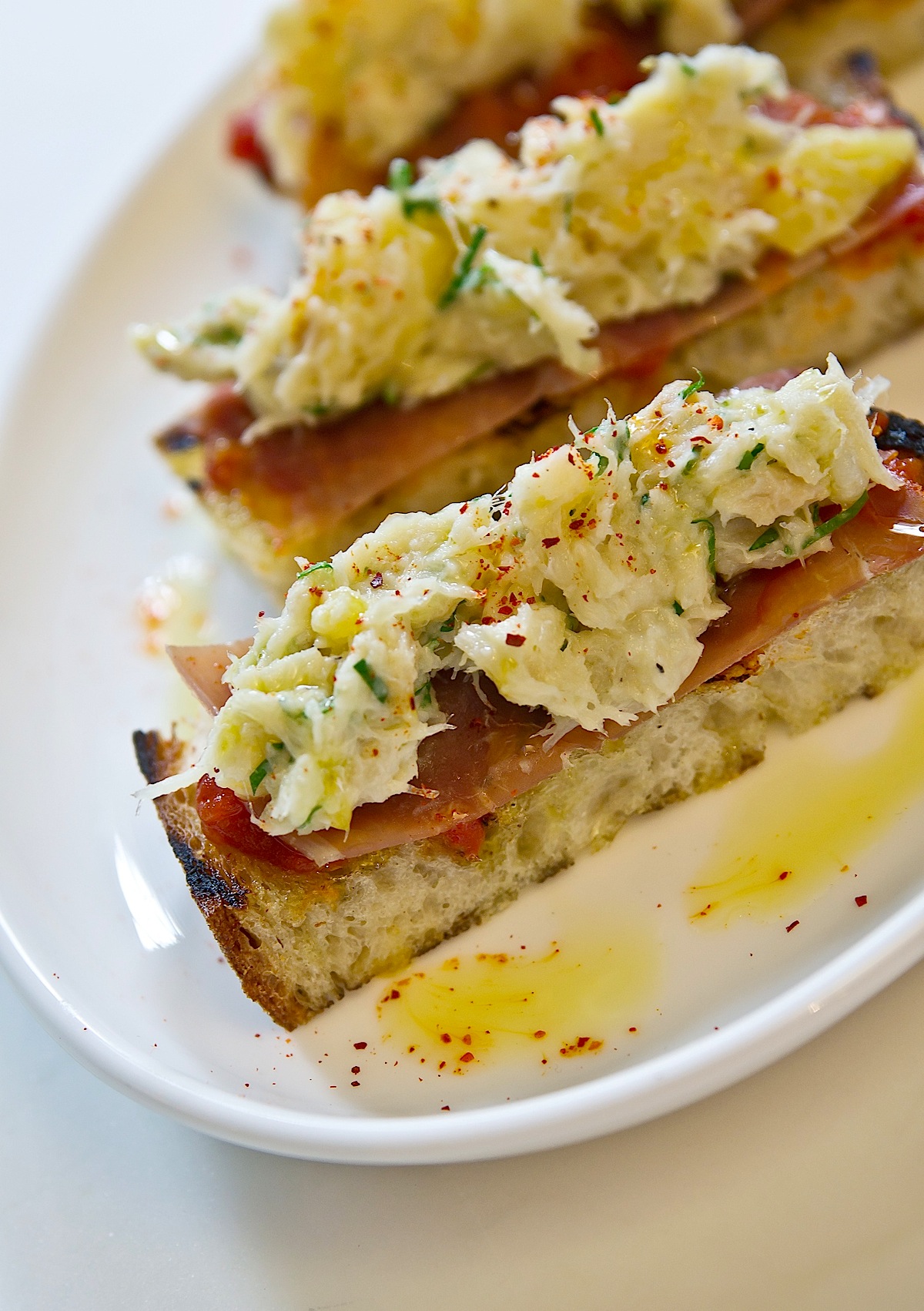 Provençale
on the menu--once a staple of French restaurants, from
which the nickname "frogs" was given to the French, as
"spaghetti eaters" was to Italians--and Allegretti and
chef de cuisine Michael Lucente's version comes in a
rich garlic cream. An autumn (now winter)
vegetable casserole contained both white and green
asparagus, Jerusalem artichokes, salsify and a black
truffle jus,
while freshly chopped veal tartare came with whole
grain mustard, salsa
verde, and crisp flatbread. Veal also figured
in vitello tonnato,
the Piedmontese twist of thinly sliced veal with
creamy tuna sauce.
Provençale
on the menu--once a staple of French restaurants, from
which the nickname "frogs" was given to the French, as
"spaghetti eaters" was to Italians--and Allegretti and
chef de cuisine Michael Lucente's version comes in a
rich garlic cream. An autumn (now winter)
vegetable casserole contained both white and green
asparagus, Jerusalem artichokes, salsify and a black
truffle jus,
while freshly chopped veal tartare came with whole
grain mustard, salsa
verde, and crisp flatbread. Veal also figured
in vitello tonnato,
the Piedmontese twist of thinly sliced veal with
creamy tuna sauce.
Next
up are the pastas, all of them lusty, like the trofie (below) with
tomatoes, capers, olives, lemon, and ventresca (tuna
belly), straight from Mediterranean sea culture.
You rarely see farotto,
the nubby grain cooked like risotto that once
sustained the Roman legions while they ripped through
Gaul; here it's made with abundant morsels of braised
veal cheeks no centurion ever got in his mess
kit. The flat wide noodles called paccheri took on
braised rabbit, toasted butternut squash and toasted
hazelnuts.
Swordfish leads the seafood
section, here marinated with hot harissa pepper,
eggplant caviar, chickpeas, Cerignola olives, lemon
verbena, and crustacean jus, as Sicilian a dish as can be
found in NYC. Sea scallops had a sweet-briny balance
and a saline touch from a pancetta-paella risotto cake, and
asparagus and tomato
diable sauce.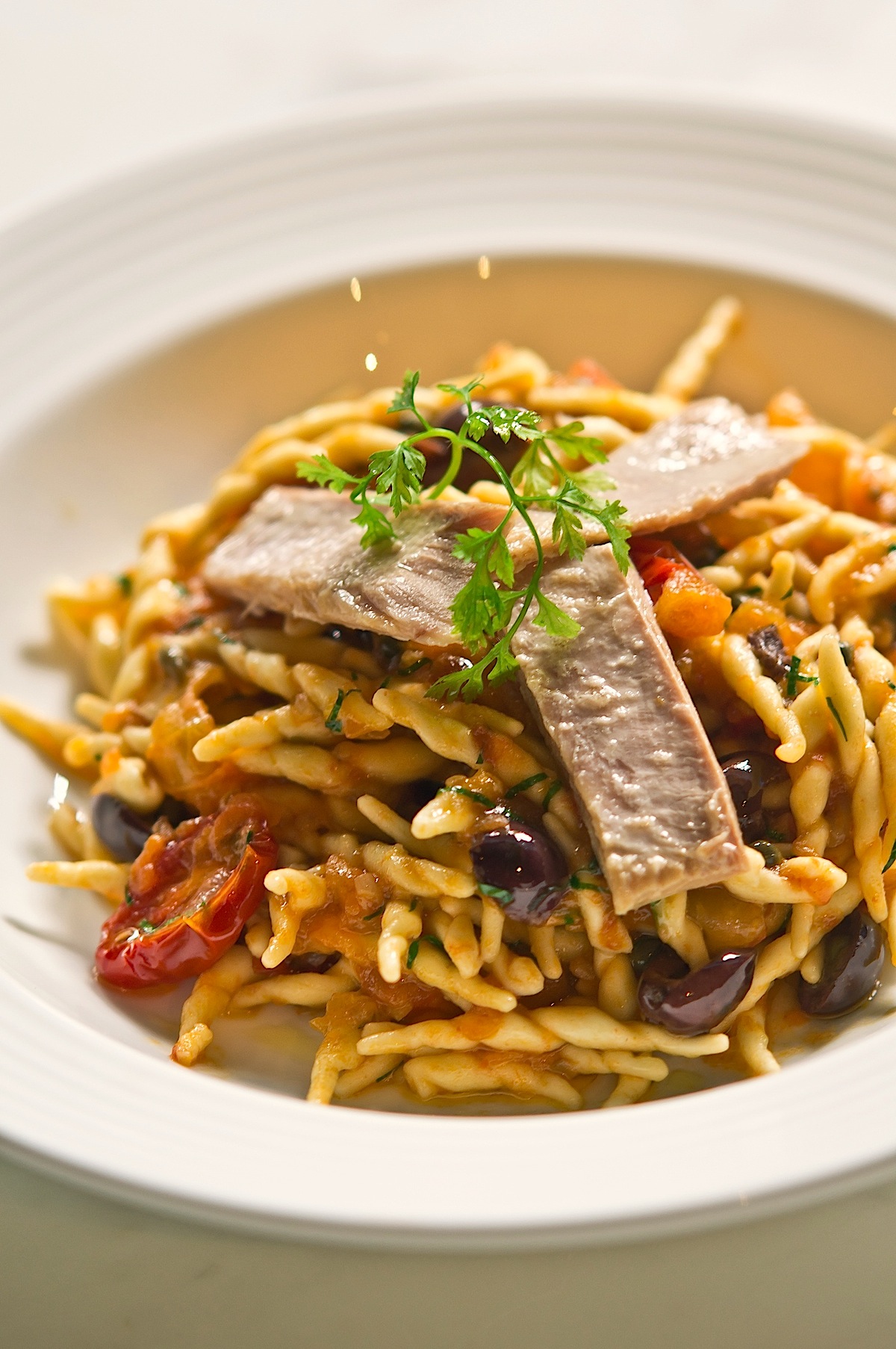
For meats, the veal medallions,
with cauliflower puree, Brussels sprouts, and
lemon-caper sauce were a little tame but took on a
slight bite from tomato marmalade, while the lamb osso
buco with braised citrus, creamy polenta, and
vegetable gratin was an ideal dish for a cold wintry
night.
Desserts feature chestnut doughnuts, a baba au rhum, a pot de creme, and
other traditional and beloved items from the French
bistro repertoire.
By the way, throughout the day,
guests may drop in for a glass of wine and nosh on
snacks like whipped ricotta with thyme and honey on
grilled country bread or merguez sausage sliders with
harissa olive tapenade and creamy cucumber, or those
heavenly fried gnocchi.
LPA's winelist is pretty
solid across the board, with plenty of bottles under
$60, which is not only right for this menu and this
neighborhood but for these times.
There are times when you sense a restaurant is
a corporate enterprise and others when it is just a
safe copy of others.
LPA is one of those rare restaurants where the
personality of the chef shines through and where you
know he personally loves the food he cooks. As Paul
Bocuse once told me, "If more chefs ate their own
food, you'd have better cuisine."
La
Promenade des Anglais is open for Lunch Mon. Fri. and
for dinner nightly. Brunch Sat. & Sun. Little
bites for the table run $8-$24, appetizers and pastas
$12-$21, main courses $24-$30.
❖❖❖
BORDEAUX AND DEAD GUYS
by Brian Freedman
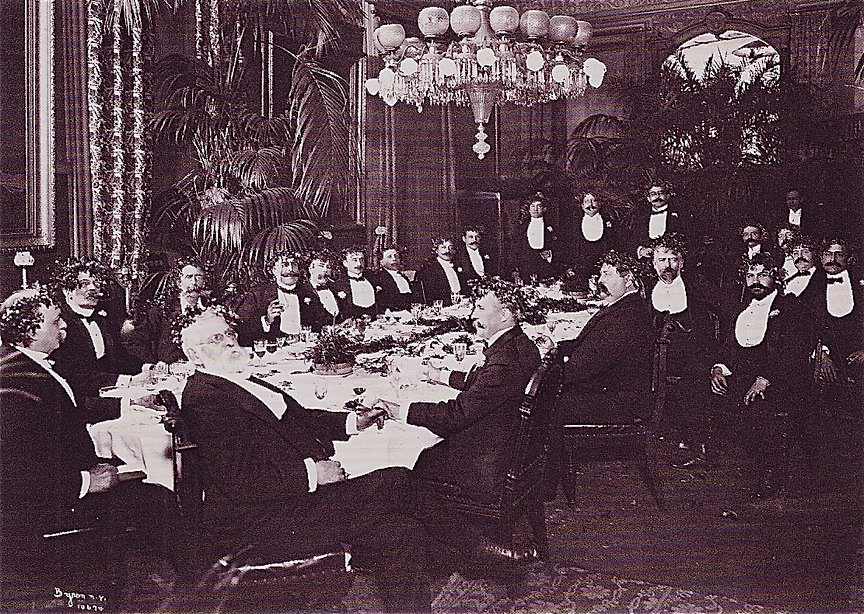
What stood out to me above all else was just how brilliantly several of the less-highly-regarded vintages showed that night: Proof, once again, that the obsessive focus on only the so-called marquee years--the ones that Wine Spectator and Parker rank 95 points and above--is a myopic approach to Bordeaux. There’s a reason this part of the world is so renowned for its grape juice, and its reputation wouldn't be what it is today--what it has been for hundreds of years--if its only worthy wines were the famous vintages.
That said, the bottlings from the classic years showed as brilliantly as they’re supposed to. The moral seems clear: Drink more Bordeaux, don’t be afraid to cellar it, and buy even in the less-than-stellar vintages. Chances are you’ll be rewarded many times over when you finally pop that cork. Just don’t wait too long.
We started with a magnum of Pichon-Baron 1992, a smoky, earth-driven, rubber-scented red that still had some time on it: An auspicious beginning. From here, we moved on to a regular bottle of La Mission Haut-Brion 2001, a feminine, concentrated beauty with notes of bright berry fruit and seamlessly integrated acid and tannins. Château La Lagune 2000 showed all the expected perfume of that vintage, as well as more lovely red fruit. Pichon-Lalande from the same legendary year exploded with concentrated toasted Indian spices and roasted fennel seeds. Lynch Bages 2002 was another smoker, with added aromas of roast beef and flowers and a mineral- and raspberry-driven palate. The Pichon-Lalande 2004 reminded me of nothing so much as tucking into a blueberry pie by a bonfire: Masculine and delicious.
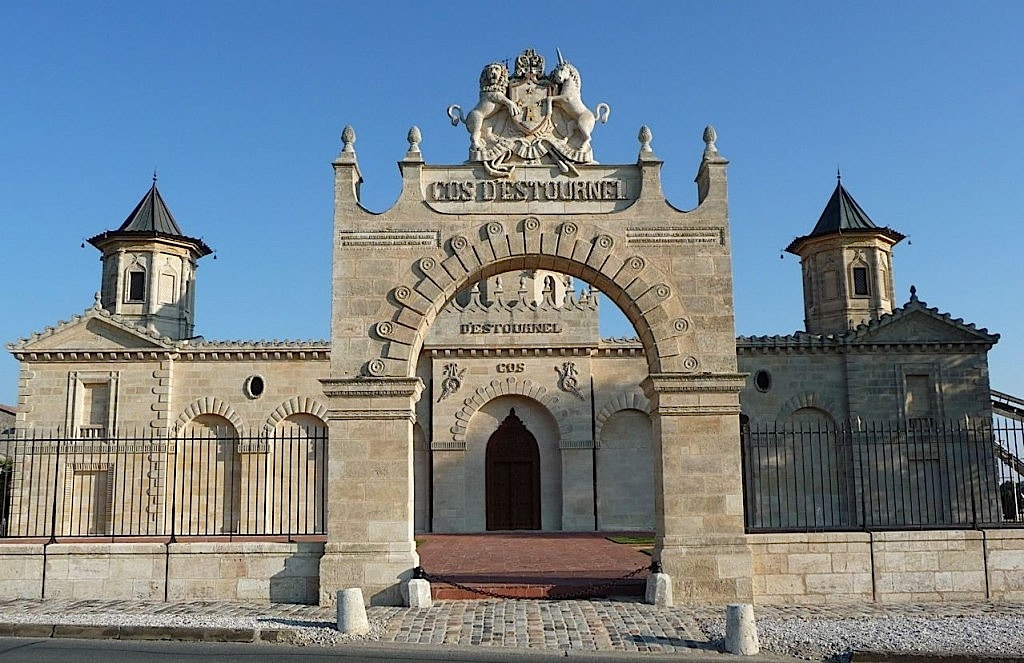
We then popped the cork on one of the most controversial wines of the past decade: Château Pavie 2003, which was at the center of a serious debate between Parker and Jancis Robinson of the Financial Times back in 2004. Its ultra-modern, super-extracted style earned 98 points from the Man from Monkton, and a painful 12 / 20 from Robinson. It was, and remains, a wine that divides people and stirs up much conversation whenever it’s opened. Personally, I loved it, and while it wasn’t anywhere near traditional Bordeaux in style, it was still identifiably Right Bank, and oozed character and flat-out sex appeal: Spicy blueberry compote, hot bricks, sage, particularly aromatic cigar flavors, and tannins that still promise another decade or two of evolution.
Back on less-fraught ground, we moved the the Château Leoville-Barton 1999, whose birch-bark and blueberry nose led to a palate of still-dusty tannins and earth that will continue to mature for another 12 to 20 years. Château Montrose 1996 was perfumed, intense, and spoke of smoky maple syrup, menthol, and eucalyptus. On the opposite end of that vintage’s spectrum was the Pichon-Lalande 1996, which smelled like the most evocative horse barn perfumed with sage, eucalyptus, and more blueberry. Lynch-Bages 1996 found itself at a far earlier stage in its evolution, the nose more giving than the remarkably tight palate, the black raspberry, scorched earth, and bonfire still holding back a bit: This will be amazing in a few years.
Four years ago, I tasted the Château Cos d’Estournel 1995 from the same friend’s cellar, and last week it showed itself to have evolved excellently. And while it easily has another five to seven+ years on it, its smoke, charred Indian spice, and blood notes were framed by easier-going sappy black cherry flavors that made it go down almost dangerously easily. Unexpectedly, the Château Léoville-Poyferré from the same vintage was one of the wines of the night, its luscious, exuberant strawberry and rhubarb character made it impossible not to drink way too quickly.
Among a line-up of 1993s, the Cos d’Éstournel was the smokier, creamier, plummier of the two, with the Ducru-Beaucaillou evoking early-autumn pine cones, high-cocoa chocolate, mint, and red cherry. Rounding out that excellent decade was a Pichon-Lalande 1990, a savory, almost briny bottling with a seam of scorched earth running down the middle.
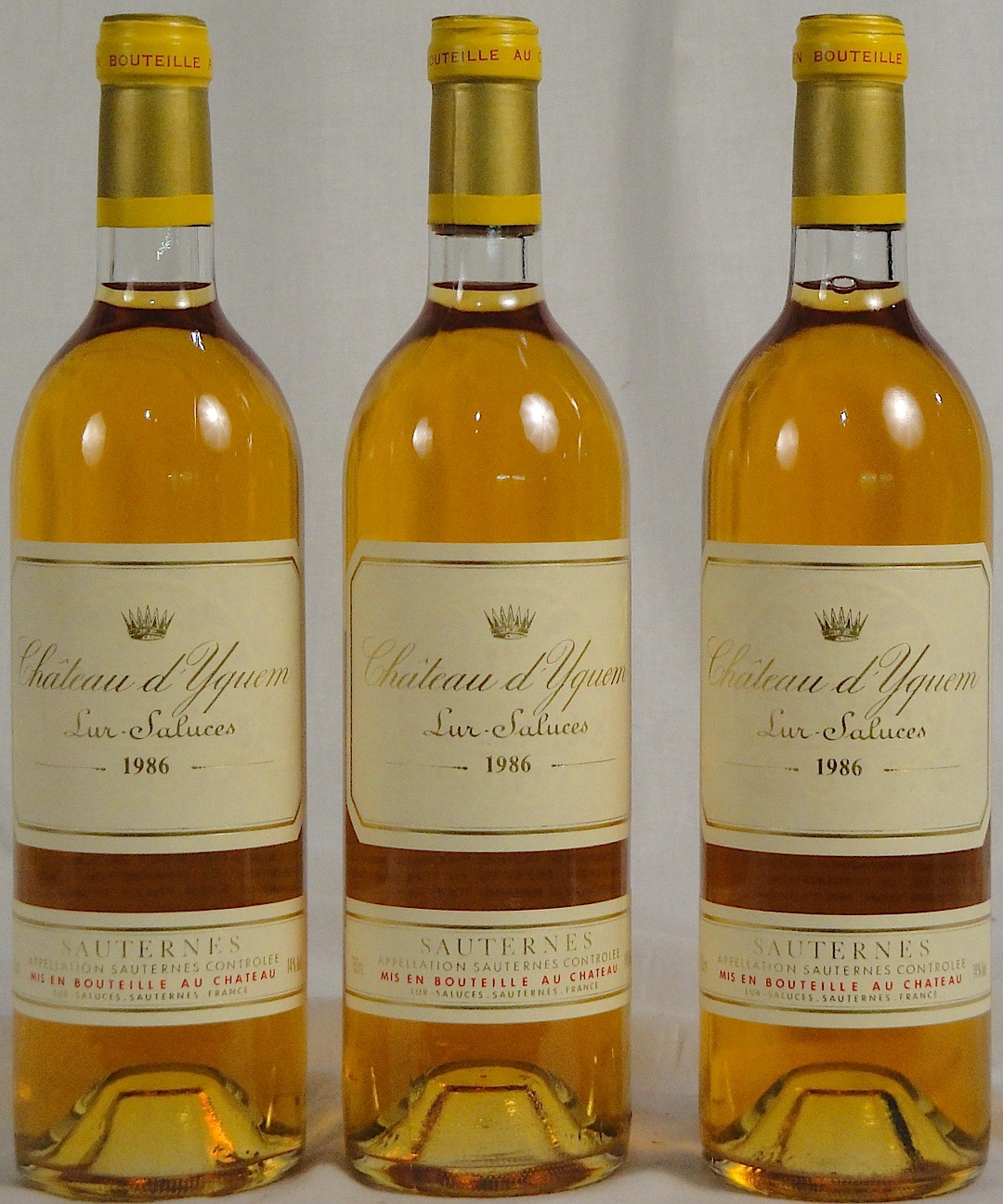 Moving on to a couple of First
Growths, the Château
Margaux 1993 was still a bit high-strung,
with taut notes of raspberry and bonfire carried on
a silky palate. Château
Haut-Brion 1988, as expected, was a
standout, its telltale stone character coming
through with clarity and framed by bright acid and
and a roasted character to the fruit. Château
Brane-Cantenac 1978 sang with menthol and
cherry, as well as smoked figs and a deeply savory
note.
Pichon-Lalande 1970 tasted of spearmint,
rosemary, and minerals, its spice still hanging on
but not destined for much more life past where it is
now. Still, it was a great, fully mature bottle. Château Lafite
Rothschild 1987, if a bit on the
light-bodied side, was still a spiced-cranberry
charmer. Château
Latour 1990 (a Wine Spectator 100-point wine),
lived up to its reputation, exuding perfectly
balanced, supremely well-integrated flavors of smoky
mint, sappy cherry fruit, minerality, and a balance
as perfectly calibrated as any wine I’ve ever been
privileged to drink. This was as profound as wine
gets.
Moving on to a couple of First
Growths, the Château
Margaux 1993 was still a bit high-strung,
with taut notes of raspberry and bonfire carried on
a silky palate. Château
Haut-Brion 1988, as expected, was a
standout, its telltale stone character coming
through with clarity and framed by bright acid and
and a roasted character to the fruit. Château
Brane-Cantenac 1978 sang with menthol and
cherry, as well as smoked figs and a deeply savory
note.
Pichon-Lalande 1970 tasted of spearmint,
rosemary, and minerals, its spice still hanging on
but not destined for much more life past where it is
now. Still, it was a great, fully mature bottle. Château Lafite
Rothschild 1987, if a bit on the
light-bodied side, was still a spiced-cranberry
charmer. Château
Latour 1990 (a Wine Spectator 100-point wine),
lived up to its reputation, exuding perfectly
balanced, supremely well-integrated flavors of smoky
mint, sappy cherry fruit, minerality, and a balance
as perfectly calibrated as any wine I’ve ever been
privileged to drink. This was as profound as wine
gets.The only place to go from there was to Château d’Yquem: The 1986, an ambrosial wine that oozed apricot, nuts, and frangipane, as well as a finish of the best rice you’ve ever tasted, and the 1975, a nutty, mushroom-rich sticky with savory apricot notes woven throughout. Brilliant way to end and remarkable night.
Thanks to Scot “Zippy” Ziskind, of ZipCo Environmental Services and My Cellar wine storage, Anthony Maffei, and the rest of the “Dead Guys” for a fantastic, educational, damn fun night. And for digging so deep into their cellars for this amazing tasting.
Brian Freedman is a food, wine, spirits, and travel writer, wine consultant, and event host and speaker. In addition to contributing to the Virtual Gourmet, he is contributing food and drinks writer for Philadelphia Style Magazine, wine columnist for Affluent Magazine, and wine specialist and resident blogger, at www.UncorkLife.com. He can be reached at bdfreedman2577@gmail.com. This column originally appeared in the Food, Drink & Travel Report: www.FDTreport.com.
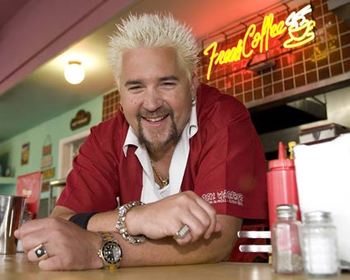
TV Food entertainer Guy Fieri is
now selling jewelry on OpenSky Airlines, including a
chain
bracelet, dog tag with chain, or a cuff link set,
for $69 each. Exclaims Fieri, "This stuff is
off-da-hook. It's some killer bling. It'll make for
a kewl gift for the holidays."
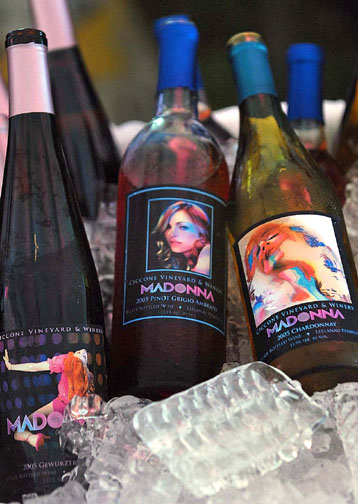 SHE THEN
SOLD THEM ON EBAY WITH HER LIPSTICK MARKS
INTACT
SHE THEN
SOLD THEM ON EBAY WITH HER LIPSTICK MARKS
INTACT
According to the Herald
Sun, Madonna and her boyfriend Brahim
Zaibat brought their own wine and wine glasses
in bag for a dinner at New York's Osteria
Cotta. They ordered arugula salad, pizza margherita,
bruschetta and roasted cauliflower. At the end, they took the empty
wine bottle and the glasses with them.
Any of John Mariani's
books below may be ordered from amazon.com.
 |
My latest book, which just won the prize for best book from International Gourmand, written with Jim Heimann and Steven Heller, Menu Design in America, 1850-1985 (Taschen Books), has just appeared, with nearly 1,000 beautiful, historic, hilarious, sometimes shocking menus dating back to before the Civil War and going through the Gilded Age, the Jazz Age, the Depression, the nightclub era of the 1930s and 1940s, the Space Age era, and the age when menus were a form of advertising in innovative explosions of color and modern design. The book is a chronicle of changing tastes and mores and says as much about America as about its food and drink.
“Luxuriating vicariously in the pleasures of this book. . . you can’t help but become hungry. . .for the food of course, but also for something more: the bygone days of our country’s splendidly rich and complex past. Epicureans of both good food and artful design will do well to make it their cofee table’s main course.”—Chip Kidd, Wall Street Journal.
“[The menus] reflect the amazing craftsmanship that many restaurants applied to their bills of fare, and suggest that today’s restaurateurs could learn a lot from their predecessors.”—Rebecca Marx, The Village Voice. |
"Eating Italian will never be the same after reading John Mariani's entertaining and savory gastronomical history of the cuisine of Italy and how it won over appetites worldwide. . . . This book is such a tasteful narrative that it will literally make you hungry for Italian food and arouse your appetite for gastronomical history."--Don Oldenburg, USA Today. "Italian
restaurants--some good, some glitzy--far
outnumber their French rivals. Many of
these establishments are zestfully described
in How Italian Food Conquered the World, an
entertaining and fact-filled chronicle by
food-and-wine correspondent John F.
Mariani."--Aram Bakshian Jr., Wall Street
Journal.
"Equal parts
history, sociology, gastronomy, and just
plain fun, How Italian Food Conquered the
World tells the captivating and delicious
story of the (let's face it) everybody's
favorite cuisine with clarity, verve and
more than one surprise."--Colman Andrews,
editorial director of The Daily
Meal.com. "A fantastic and fascinating
read, covering everything from the influence
of Venice's spice trade to the impact of
Italian immigrants in America and the
evolution of alta cucina. This book will
serve as a terrific resource to anyone
interested in the real story of Italian
food."--Mary Ann Esposito, host of PBS-TV's
Ciao
Italia. "John Mariani has written the
definitive history of how Italians won their
way into our hearts, minds, and
stomachs. It's a story of pleasure over
pomp and taste over technique."--Danny Meyer,
owner of NYC restaurants Union Square Cafe,
Gotham Bar & Grill, The Modern, and
Maialino.
|
 |
 |
 |
 |
 |
 |
 |
 |
 Everett Potter's Travel Report:
Everett Potter's Travel Report: 
 Eating Las Vegas
is the new on-line site for Virtual Gourmet
contributor John A. Curtas., who since 1995
has been commenting on the Las Vegas food
scene and reviewing restaurants for Nevada
Public Radio. He is also the
restaurant critic for KLAS TV, Channel 8 in
Las Vegas, and his past reviews can be
accessed at KNPR.org.
Click on the logo below to go directly to
his site.
Eating Las Vegas
is the new on-line site for Virtual Gourmet
contributor John A. Curtas., who since 1995
has been commenting on the Las Vegas food
scene and reviewing restaurants for Nevada
Public Radio. He is also the
restaurant critic for KLAS TV, Channel 8 in
Las Vegas, and his past reviews can be
accessed at KNPR.org.
Click on the logo below to go directly to
his site.

Tennis Resorts Online: A Critical Guide to the World's Best Tennis Resorts and Tennis Camps, published by ROGER COX, who has spent more than two decades writing about tennis travel, including a 17-year stretch for Tennis magazine. He has also written for Arthur Frommer's Budget Travel, New York Magazine, Travel & Leisure, Esquire, Money, USTA Magazine, Men's Journal, and The Robb Report. He has authored two books-The World's Best Tennis Vacations (Stephen Greene Press/Viking Penguin, 1990) and The Best Places to Stay in the Rockies (Houghton Mifflin, 1992 & 1994), and the Melbourne (Australia) chapter to the Wall Street Journal Business Guide to Cities of the Pacific Rim (Fodor's Travel Guides, 1991).


The Family Travel Forum - A
community for those who "Have Kids, Still Travel" and
want to make family vacations more fun, less work and
better value. FTF's travel and parenting features,
including reviews of tropical and ski resorts, reunion
destinations, attractions, holiday weekends, family
festivals, cruises, and all kinds of vacation ideas
should be the first port of call for family vacation
planners. http://www.familytravelforum.com/index.html
ALL YOU NEED BEFORE YOU GO


MARIANI'S VIRTUAL GOURMET
NEWSLETTER is published weekly. Editor/Publisher: John
Mariani.
Contributing Writers: Christopher Mariani, Robert Mariani,
John A. Curtas, Edward Brivio, Mort Hochstein,
Suzanne Wright, and Brian Freedman. Contributing
Photographers: Galina Stepanoff-Dargery,
Bobby Pirillo. Technical Advisor: Gerry McLoughlin.
To un-subscribe from this newsletter,click here.
© copyright John Mariani 2012
